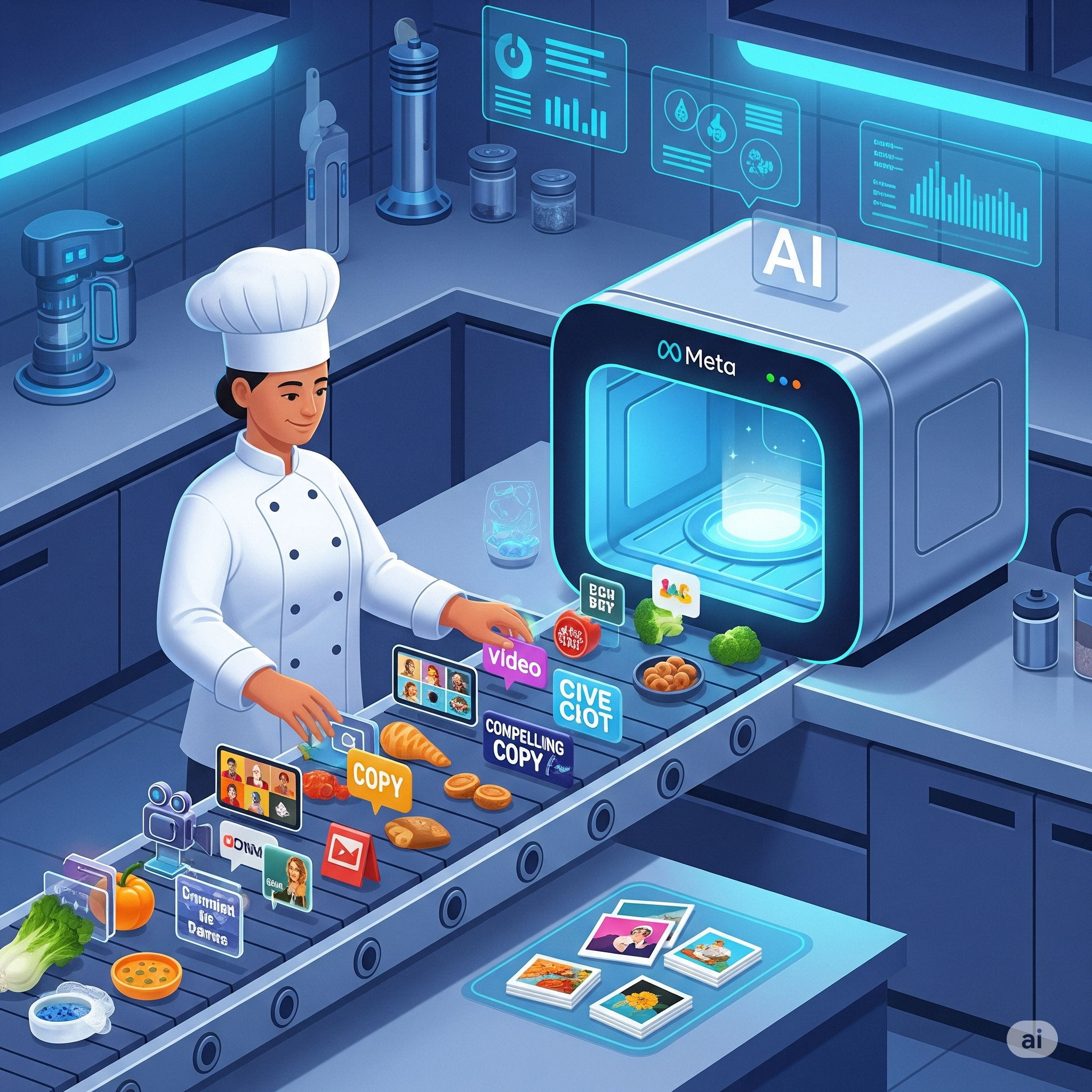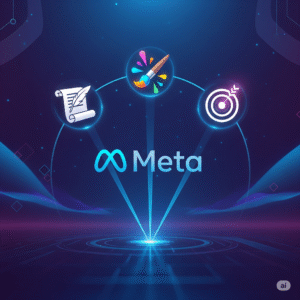We’ve entered a new era of advertising on Meta. The age of obsessively tweaking audience targeting is over. With the dominance of Advantage+ and broad targeting, the AI has taken the wheel on finding who to show your ads to. This leaves one monumental question for us marketers: what, exactly, should we be showing them? In this new reality, your ad creative isn’t just part of the equation—it is the equation. The quality of your inputs will directly determine the quality of your results.(creative for Meta AI)
The problem is, most advertisers are still creating ads like it’s 2019. They build one “perfect” ad and hope it works. But Meta’s AI doesn’t want one perfect ad; it wants a portfolio of strong, diverse ingredients it can use to assemble the perfect ad for each individual user. After years of testing and millions in ad spend, I’ve developed a proven formula for creating the ideal creative for Meta AI. This is my playbook for feeding the algorithm what it craves to deliver outstanding results.
The AI’s Appetite: Core Principles of Creative for Meta AI
To win the game, you have to understand the rules. Meta’s AI isn’t a black box; it has preferences. It thrives on specific types of inputs that allow it to learn and optimize at maximum speed. If you want to master AI creative optimization, you need to understand its appetite.
The Two Pillars: Data and Variety
At its core, the algorithm wants two things from your creative:
- Data: The AI needs to understand what it’s looking at and what your message is. This means clear visuals where the product or offer is easily identifiable. It means concise copy that communicates a clear value proposition. Ambiguous, “artsy” ads that a human might appreciate can often confuse the AI, leading to poor performance.
- Variety: The AI needs options. Providing it with a diverse range of assets is like giving a master chef a fully stocked pantry. The more distinct ingredients (images, videos, headlines, copy angles) you provide, the more combinations it can test, and the faster it can learn what resonates with different segments of your audience. Crafting this variety is the essence of how to design ads for Advantage+.
Thinking like an AI means you stop trying to be a master painter creating a single masterpiece. Instead, you become a master chef, sourcing the highest-quality ingredients and trusting the chef (the AI) to combine them into a world-class meal for each individual diner. This is the fundamental mindset shift required to produce winning creative for Meta AI.
The Formula, Part 1: The Ultimate Visual Creative for Meta AI
Your visual asset—the image or video—is the first thing a user sees. It’s responsible for stopping the scroll and earning you a precious few seconds of attention. Here’s how to create visuals that the AI loves.
The Undisputed Champion: UGC and AI Ads
If there is one “silver bullet” for visual creative, it’s User-Generated Content (UGC). UGC refers to videos or photos created by real customers, which look and feel native to the social media feed. The reason UGC and AI ads are such a powerful combination is rooted in authenticity.
Today’s consumers are savvy. They can spot a polished, corporate ad from a mile away. A genuine video from a customer using your product in their home builds instant trust and social proof. For the AI, UGC is pure gold. It’s packed with authentic data signals about how real people interact with your product. It’s the single most effective type of creative for Meta AI you can produce.
Choosing the Best Ad Formats for AI
While UGC is king, you should still provide the AI with a mix of formats.
- Short-Form Vertical Video: This is the premier format. Aim for videos under 15 seconds, formatted for Reels and Stories (9:16). The first 3 seconds must have a powerful hook (e.g., a question, a bold statement, a surprising visual). Use fast cuts, on-screen text captions, and a clear call-to-action.
- High-Contrast Static Images: Your images should be bright, clear, and visually arresting. Showcase your product in a lifestyle context, being used by a person. Contrast your product against the background to make it “pop.” Don’t be afraid to test simple graphics with bold text, either. The key is to provide a mix of polished studio shots and more lo-fi, authentic-looking photos.
The Formula, Part 2: Crafting the Perfect Text Creative for Meta AI
Your ad copy provides the context and the persuasive argument. Just like with visuals, the AI thrives when you give it a variety of distinct angles to test.
The “Angle” Strategy for Headlines and Copy
Never provide just one headline. Your goal is to write 3-5 headlines for every ad, with each one testing a different psychological trigger. This is the most effective way to approach testing ad copy with AI. Here are five angles to always include:
- Problem/Solution: State a pain point and present your product as the solution. (e.g., “Tired of dull skin? Get a radiant glow.”)
- Benefit-Driven: Focus on the outcome, not the features. (e.g., “The softest sheets you’ll ever sleep on.”)
- Social Proof: Leverage testimonials or numbers. (e.g., “Join 50,000+ happy customers.”)
- Question-Based: Engage the user directly and make them think. (e.g., “Ready to upgrade your morning coffee?”)
- Scarcity/Urgency: Encourage immediate action. (e.g., “Limited edition – sale ends tonight.”)
By providing these distinct angles, you allow the AI to discover that, for example, younger audiences might respond to the question-based headline, while older audiences convert on the benefit-driven one.
The Formula in Action: Two Mini Case Studies
Let’s look at how applying this formula for creative for Meta AI delivered real results.
Case Study 1: “DermaPure” – The Skincare Brand
DermaPure was running ads with beautiful, polished studio photos of their products. The results were mediocre. We implemented our formula by having them source five simple, authentic UGC videos from real customers demonstrating their morning skincare routine. We combined this with our “Angle” copy strategy. The result? The authenticity of the UGC and AI ads resonated deeply. Their Cost Per Acquisition (CPA) dropped by 40% in the first month because the AI had better, more trustworthy creative to work with.
Case Study 2: “CoinFlow” – The Fin-Tech App
This app’s ads were filled with confusing technical jargon about financial markets. We applied the formula to their text creative for Meta AI. We kept their existing visuals but wrote five new headlines using our “Angle” strategy: a Problem/Solution angle (“Confused by investing?”), a Benefit-Driven angle (“Build wealth with just $5”), and a Social Proof angle (“The app rated 4.9 stars by 10,000+ investors”). The AI-powered testing quickly found the best-performing message for different audience segments, leading to a 200% increase in their click-through rate.
Your Workflow and AI-Powered Toolkit
Implementing this formula is a systematic process.
- Brainstorm Angles: Before creating anything, map out the different messaging angles you want to test.
- Create a Diverse Asset Library: Source or create 3-5 videos (prioritizing UGC) and 3-5 static images.
- Write Your Copy Variants: Write 3-5 headlines and 2-3 primary text options based on your angles.
- Assemble in Advantage+ Creative: Load all your ingredients into an ad using Advantage+ Creative and let the AI do the work.
- Analyze Asset Performance: After a week, use the “Breakdown” feature in Ads Manager to see which individual assets (headlines, images) are performing best, and use those insights to inform your next batch of creative.
To execute this at scale, leverage other AI tools. As OpenAI’s own resources show, generative AI is built to be a powerful assistant. Use ChatGPT to generate dozens of headline angles in seconds. For a deeper analysis of which creative themes drive revenue, a BI tool like Tableau is invaluable. A great primer on marketing reporting can be found in this article from HubSpot.
The New High-Value Skill
Creating effective creative for Meta AI is the new high-leverage skill for modern marketers. The days of finding a secret audience are gone. The winners of tomorrow will be those who can consistently feed Meta’s AI a diverse, high-quality diet of authentic visuals and angle-driven copy. Stop trying to build one perfect ad. Start building a portfolio of perfect ingredients.
AI Audience Case Study: How We Scaled an E-commerce Brand from $0 to $100k/mo
AI Retargeting Meta: Recapturing Lost Customers in the Age of Advantage+



